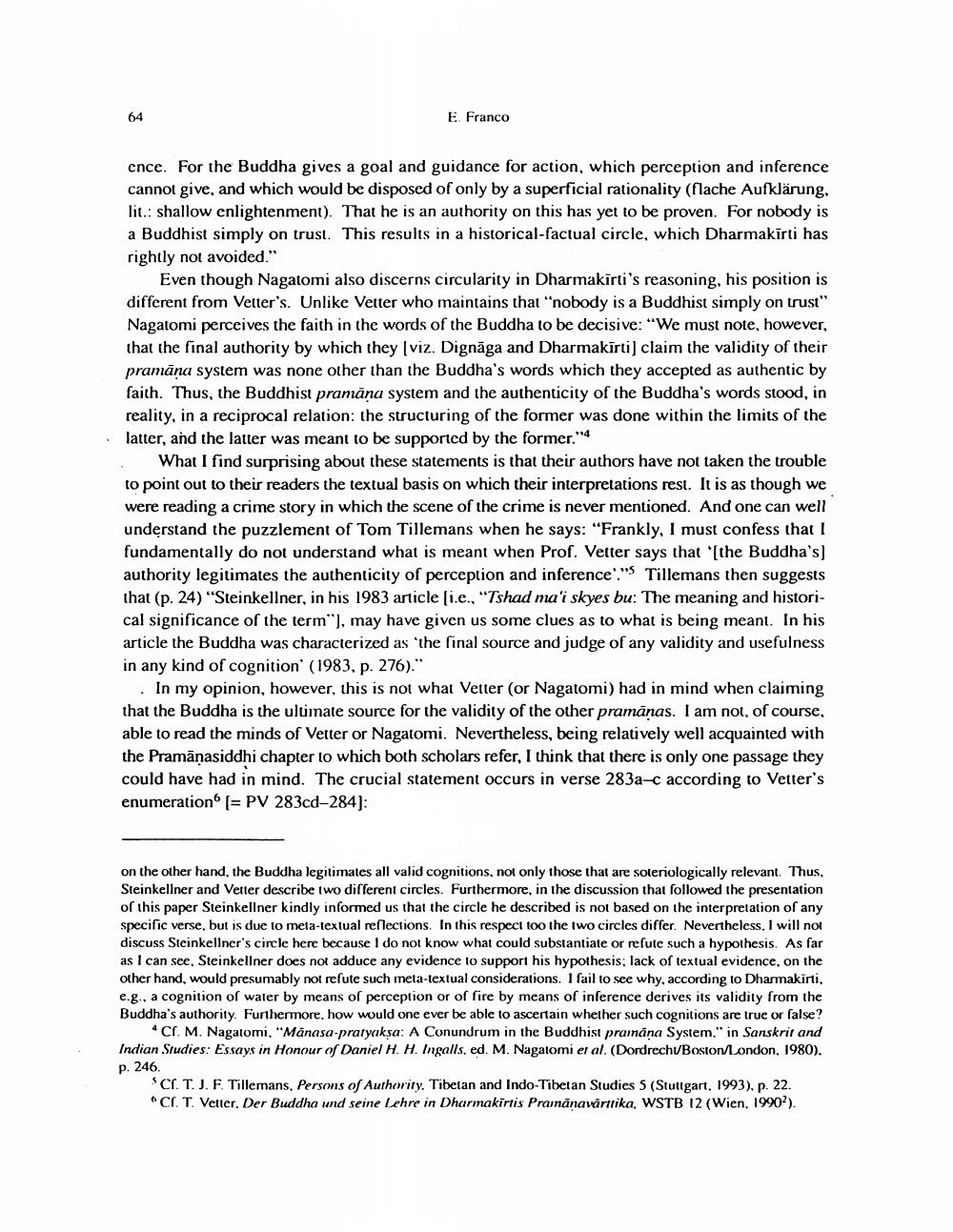Book Title: Two Circles Or Parallel Lines Author(s): Eli Franco Publisher: Eli Franco View full book textPage 2
________________ 64 E. Franco ence. For the Buddha gives a goal and guidance for action, which perception and inference cannot give, and which would be disposed of only by a superficial rationality (flache Aufklärung, lit.: shallow enlightenment). That he is an authority on this has yet to be proven. For nobody is a Buddhist simply on trust. This results in a historical-factual circle, which Dharmakirti has rightly not avoided." Even though Nagatomi also discerns circularity in Dharmakirti's reasoning, his position is different from Vetter's. Unlike Vetter who maintains that "nobody is a Buddhist simply on trust" Nagatomi perceives the faith in the words of the Buddha to be decisive: "We must note, however, that the final authority by which they [viz. Dignaga and Dharmakirti] claim the validity of their pramāṇa system was none other than the Buddha's words which they accepted as authentic by faith. Thus, the Buddhist pramāna system and the authenticity of the Buddha's words stood, in reality, in a reciprocal relation: the structuring of the former was done within the limits of the latter, and the latter was meant to be supported by the former."4 What I find surprising about these statements is that their authors have not taken the trouble to point out to their readers the textual basis on which their interpretations rest. It is as though we were reading a crime story in which the scene of the crime is never mentioned. And one can well understand the puzzlement of Tom Tillemans when he says: "Frankly, I must confess that I fundamentally do not understand what is meant when Prof. Vetter says that '[the Buddha's] authority legitimates the authenticity of perception and inference'." Tillemans then suggests that (p. 24) "Steinkellner, in his 1983 article [i.e., "Tshad ma'i skyes bu: The meaning and historical significance of the term"], may have given us some clues as to what is being meant. In his article the Buddha was characterized as 'the final source and judge of any validity and usefulness in any kind of cognition' (1983, p. 276)." In my opinion, however, this is not what Vetter (or Nagatomi) had in mind when claiming that the Buddha is the ultimate source for the validity of the other pramānas. I am not, of course, able to read the minds of Vetter or Nagatomi. Nevertheless, being relatively well acquainted with the Pramāṇasiddhi chapter to which both scholars refer, I think that there is only one passage they could have had in mind. The crucial statement occurs in verse 283a-c according to Vetter's enumeration" [= PV 283cd-284]: on the other hand, the Buddha legitimates all valid cognitions, not only those that are soteriologically relevant. Thus, Steinkellner and Vetter describe two different circles. Furthermore, in the discussion that followed the presentation of this paper Steinkellner kindly informed us that the circle he described is not based on the interpretation of any specific verse, but is due to meta-textual reflections. In this respect too the two circles differ. Nevertheless, I will not discuss Steinkellner's circle here because I do not know what could substantiate or refute such a hypothesis. As far as I can see, Steinkellner does not adduce any evidence to support his hypothesis; lack of textual evidence, on the other hand, would presumably not refute such meta-textual considerations. I fail to see why, according to Dharmakirti, e.g., a cognition of water by means of perception or of fire by means of inference derives its validity from the Buddha's authority. Furthermore, how would one ever be able to ascertain whether such cognitions are true or false? * Cf. M. Nagatomi, “Mānasa-pratyakṣa: A Conundrum in the Buddhist pramāna System." in Sanskrit and Indian Studies: Essays in Honour of Daniel H. H. Ingalls, ed. M. Nagatomi et al. (DordrechuBoston/London, 1980). p. 246. Cf. T. J. F. Tillemans, Persons of Authority. Tibetan and Indo-Tibetan Studies 5 (Stuttgart, 1993), p. 22. Cf. T. Vetter, Der Buddha und seine Lehre in Dharmakirtis Pramāṇavārttika, WSTB 12 (Wien, 19902).Page Navigation
1 2 3 4 5 6 7 8 9 10
